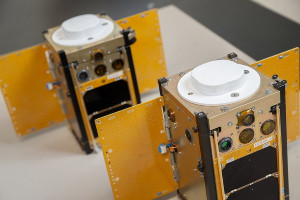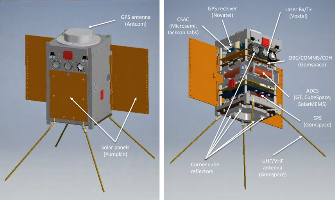| Satellite name | RANGE (Ranging And Nanosatellite Guidance Experiment) |
|---|---|
| Spacecraft type | CubeSat |
| Units or mass | 1.5U |
| Organisation | Georgia Institute of Technology (Georgia Tech) |
| Institution | University |
| Entity type | Academic / Education |
| Headquarters | US |
| Launch brokerer | Spaceflight |
| Oneliner |
Formation flying and inter-satellite laser ranging system, which also supports communications. |
| Description |
Two CubeSats that will fly in a leader-follower formation. The on-board instrumentation will include state-of-the-art global positioning system (GPS) receivers, linked to miniaturized atomic clocks, for precise orbit determination. The relative positions of the satellites will be measured using a compact inter-satellite laser ranging system that will also double as a laser communications system. Goal is to have at least one set of coincident ground-based satellite laser ranging, high-rate GPS, and inter-satellite laser ranging measurements. Potential to measure the relative distance between the satellites down to millimeters. Corner cube reflectors will allow the absolute and relative position estimates to be verified using ground-based satellite laser ranging (SLR) measurements provided by the International Laser Ranging Service (ILRS). |
| Sources | [1] [2] [3] [4] |
| Photo sources | [1] [2] [3] |
| Keywords | Formation flying, Laser transmitter |
Related Spacecraft
| Satellite | Status | Launcher | Date | Orbit |
|---|---|---|---|---|
| RANGE-A (Ranging And Nanosatellite Guidance Experiment) | Semi-operational? (Website only says it is in mission operations phase. Last SatNOGS report with data2023-05-02 but repetitive data. Possibly some nominal packets from 2020. Last checked 2023-06-10) | Falcon 9, (Spaceflight SSO-A, SHERPA) | 2018-12-03 | 580 km, 97.8 deg |
| RANGE-B (Ranging And Nanosatellite Guidance Experiment) | Semi-operational? (Website only says it is in mission operations phase. Last SatNOGS report with data 2023-06-07 but repetitive data. Last checked 2023-06-10) | Falcon 9, (Spaceflight SSO-A, SHERPA) | 2018-12-03 | 580 km, 97.8 deg |
Last modified: 2023-06-10


